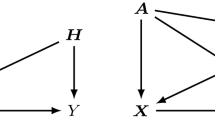Abstract
Treatment analyses based on average outcomes do not immediately generalize to the case of ordered responses because the expectation of an ordinally measured variable does not exist. The proposed remedy in this paper is a shift in focus to distributional effects. Assuming a threshold crossing model on both the ordered potential outcomes and the binary treatment variable, and leaving the distribution of error terms and functional forms unspecified, the paper discusses how the treatment effects can be bounded. The construction of bounds is illustrated in a simulated data example.
Similar content being viewed by others
References
Angrist JD, Imbens GW, Rubin D (1996) Identification of causal effects using instrumental variables. J Am Stat Assoc 91: 444–455
Bellemare C, Melenberg B, van Soest A (2002) Semi-parametric models for satisfaction with income. Por Econ J 1: 181–203
Björklund A., Moffitt R (1987) The estimation of wage gains and welfare gains in self-selection. Rev Econ Stat 69: 42–49
Boes S, Winkelmann R (2006) Ordered response models. Allg Stat Arch 90: 165–180
Coppejans M (2007) On efficient estimation of the ordered response model. J Econ 137: 577–614
Cunha F, Heckman JJ, Navarro S (2007) The identification and economic content of ordered choice models with stochastic thresholds. Int Econ Rev 48: 1273–1309
DeVaro J (2006) Teams, autonomy, and the financial performance of firms. Industrial Relat 45: 217–269
Greene W, Hensher D (2010) Modeling ordered choices. Cambridge University Press (forthcoming)
Heckman JJ (1997) Instrumental variables: a study of implicit behavioral assumptions used in making program evaluations. J Hum Resour 32: 441–462
Heckman JJ, Robb R (1985) Alternative methods for estimating the impact of interventions. In: Heckman JJ, Singer B (eds) Longitudinal analysis of labor market data. Cambridge University Press, New York, pp 156–245
Heckman JJ, Robb R (1986) Alternative methods for solving the problem of selection bias in evaluating the impact of treatments on outcomes. In: Wainer J (eds) Drawing inference from self-selected samples. Springer, New York, pp 63–107
Heckman JJ, Vytlacil EJ (1999) Local instrumental variables and latent variable models for identifying and bounding treatment effects. Proc Natl Acad Sci 96: 4730–4734
Heckman JJ, Vytlacil EJ (2001a) Instrumental variables, selection models, and tight bounds on the average treatment effect. In: Lechner M, Pfeiffer F (eds) Econometric evaluation of labour market policies. Physica, Heidelberg, pp 1–15
Heckman JJ, Vytlacil EJ (2001b) Local instrumental variables. In: Hsiao C, Morimune K, Powell J (eds) Nonlinear statistical inference: essays in honor of Takeshi Amemiya. Cambridge University Press, Cambridge, pp 1–46
Heckman JJ, Vytlacil EJ (2005) Structural equations, treatment effects, and econometric policy evaluation. Econometrica 73: 669–738
Heckman JJ, LaLonde RJ, Smith JA (1999) The economics and econometrics of active labor market programs. In: Ashenfelter O, Card D (eds) Handbook of labor economics, vol 3. North Holland, Amsterdam, pp 1865–2097
Imbens GW, Angrist JD (1994) Identification and estimation of local average treatment effects. Econometrica 62: 467–476
Klein RW, Sherman RP (2002) Shift restrictions and semiparametric estimation in ordered response models. Econometrica 70: 663–692
Lewbel A (1997) Semiparametric estimation of location and other discrete choice moments. Econ Theory 13: 32–51
Lewbel A (2003) Ordered responce threshold estimation. Unpublished working paper, Boston College
Li M, Tobias JL (2008) Bayesian analysis of treatment effects in an ordered potential outcomes model. In: Millimet D, Smith JA, Vytlacil EJ (eds) Advances in econometrics, vol 21: estimating and evaluating treatment effects in econometrics. Elsevier, Oxford, pp 57–91
Luechinger S, Stutzer A, Winkelmann R (2010) Self-selection models for public and private sector job satisfaction. Res Labor Econ (forthcoming)
Mann HB, Whitney DR (1947) On a test of whether one of two random variables is stochastically larger than the other. Ann Math Stat 18: 50–60
Manski CF (1990) Nonparametric bounds on treatment effects. Am Econ Rev 80: 319–323
Manski CF (1994) The selection problem. In: Sims C (eds) Advances in econometrics: Sixth World Congress, vol 1. Cambridge University Press, Cambridge, pp 143–170
Manski CF (1995) Identification problems in the social sciences. Harvard University Press, Cambridge
Manski CF (2000) Identification problems and decisions under ambiguity: empirical analysis of treatment response and normative analysis of treatment choice. J Econ 95: 415–442
Manski CF (2003) Partial identification of probability distributions. Springer, New York
Manski CF (2007) Identification for prediction and decision. Harvard University Press, Cambridge
Manski CF, Pepper J (2000) Monotone instrumental variables: with an application to the returns to schooling. Econometrica 68: 997–1010
McCullagh P (1980) Regression models for ordinal data. J R Stat Soc Ser B (Methodol) 42: 109–142
McKelvey RD, Zavoina W (1975) A statistical model for the analysis of ordinal level dependent variables. J Math Sociol 4: 103–120
Munkin MK, Trivedi PK (2008) Bayesian analysis of the ordered probit model with endogenous selection. J Econ 143: 334–348
Neyman J (1923) On the application of probability theory to agricultural experiments. Essay on principles, Sect 9. Stat Sci 5: 465–480 (translated)
Rubin DB (1974) Estimating causal effects of treatments in randomized and nonrandomized studies. J Educ Psychol 66: 688–701
Scharfstein DO, Manski CF, Anthony JC (2004) On the construction of bounds in prospective studies with missing ordinal outcomes: application to the good behavior game trial. Biometrics 60: 154–164
Shaikh AM, Vytlacil EJ (2005) Threshold crossing models and bounds on treatment effects: a nonparametric analysis. NBER Technical Working Papers t0307
Stewart MB (2004) Semi-nonparametric estimation of extended ordered probit models. Stata J 4: 27–39
Vytlacil EJ (2002) Independence, monotonicity, and latent index models: an equivalence result. Econometrica 70: 331–341
Vytlacil EJ (2006) A note on additive separability and latent index models of binary choice: representation results. Oxf Bull Econ Stat 68: 515–518
Author information
Authors and Affiliations
Corresponding author
Rights and permissions
About this article
Cite this article
Boes, S. Nonparametric analysis of treatment effects in ordered response models. Empir Econ 44, 81–109 (2013). https://doi.org/10.1007/s00181-010-0354-y
Received:
Accepted:
Published:
Issue Date:
DOI: https://doi.org/10.1007/s00181-010-0354-y
Keywords
- Nonparametric bounds
- Causal effects
- Instrumental variables
- Endogenous binary regressor
- Partial identification




